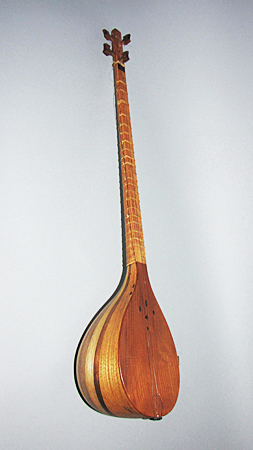
Owner: HWMC
Catalog#: ME-CHLT-04-14
Lutes
Iran ‘Setar’
Iran
Iranian
Mulberry Wood, metal strings, nylon strings
Mid-20th century
Length: 32 in
Chordophones – Lutes
The setar (sehtar) is a long neck lute used in Persian traditional music. It is a member of the tanbur family of long-necked lutes originating in Mesopotamia, Southern or Central Asia. It has a pitch range of more than two and a half octaves. Originally it had three strings (the name setar means “three strings”); however, by the mid-19th century, a fourth string was added: The first two are single, the lower is double in octaves (the tuning would be: cc’ g c’.). This setar has 10 ribs glued together. The sound board has small holes drilled in a geometric pattern in the front. The neck is a separate piece of wood from the sound board and has 24 nylon frets. There are four T-shaped pegs at the top, two to the left of the pegbox and two in front. The setar is played with the index finger of the right hand. It is played mainly in the classical Dastgah music of Iran. It is also played by the Sufi mystics.
Reference: https://www.atlasofpluckedinstruments.com/middle_east
